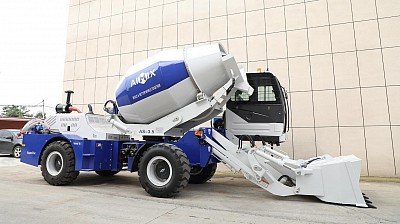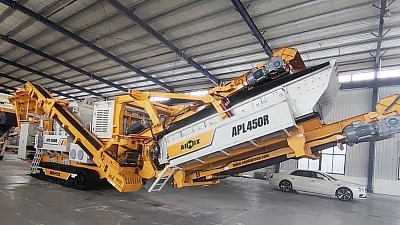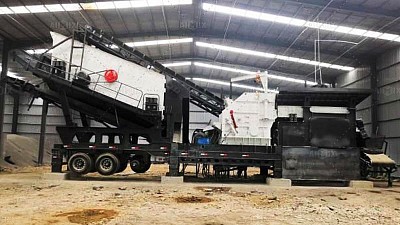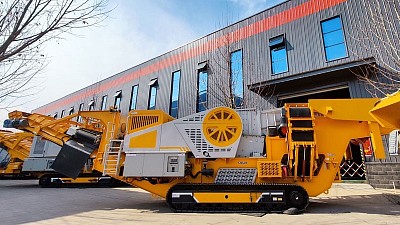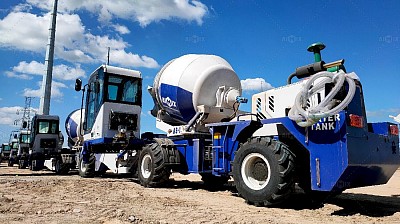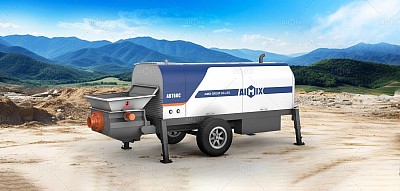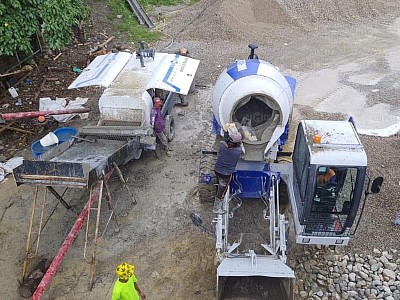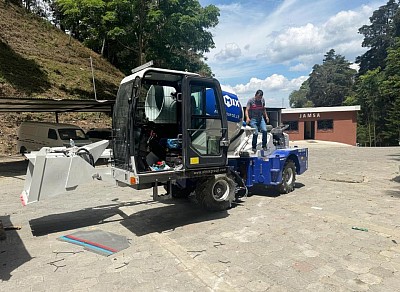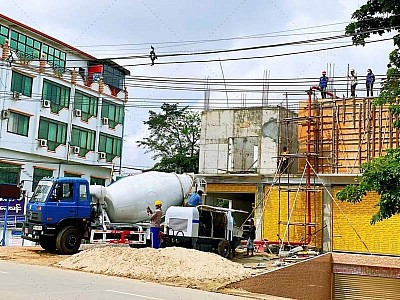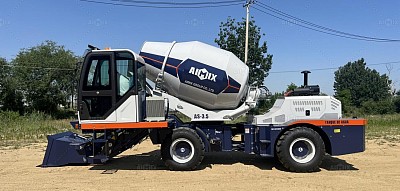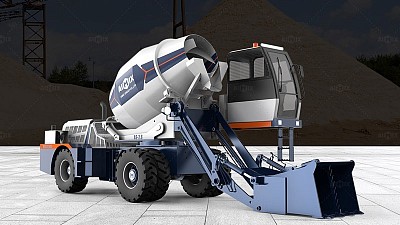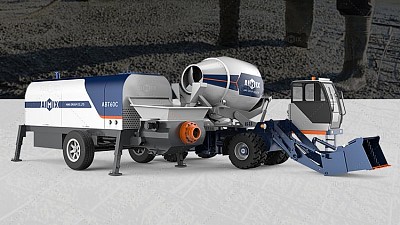Blogs about different equipments
Effectively Managing Inspection Risks for Mobile Stone Crushers in Latin America
The export market for mobile stone crushers in Latin America has been steadily growing, driven by the region’s booming mining and construction industries. However, the complexity of international trade, combined with varied environmental and operational conditions, introduces a range of risks during the inspection process. Ensuring that the crushers meet quality standards and are ready for deployment in challenging environments is critical to avoid delays, defects, and costly returns.
In this article, we will explore how manufacturers and buyers can effectively manage inspection risks for aggregate crusher plants and stone crushers exported to Latin America. From pre-shipment inspections to ensuring that the machinery meets local operational needs, proper risk management can ensure a smooth transaction and minimize unexpected costs.
Why Inspection Risks Are Crucial for Mobile Stone Crushers
Inspection risks are particularly high when dealing with mobile stone crushers(trituradora de piedra movil), as these machines are often complex and customized to handle different aggregates and environmental conditions. For exporters targeting Latin America, these risks are compounded by factors like remote locations, fluctuating regulatory standards, and diverse climatic conditions.
A thorough inspection process is essential for verifying that the equipment meets both international and local standards. However, without a clear strategy, the risks of encountering substandard equipment, delays in shipment, or unforeseen operational failures upon installation can be significant.
Key Steps to Manage Inspection Risks
1. Conduct Thorough Pre-shipment Inspections The first step in managing inspection risks is ensuring a comprehensive pre-shipment inspection. This should be done by an experienced inspection team that is familiar with the mobile stone crusher design, performance standards, and safety requirements for the Latin American market.
Pre-shipment inspections should cover several critical aspects:
- Functional Testing: Verify that all parts of the crusher are operating correctly under load. This includes testing the crushing mechanism, conveyors, and hydraulic systems.
- Component Quality Check: Inspect critical components for signs of wear or damage during transport. Ensure that the crusher’s main parts meet the durability standards required for long-term operation.
- Compliance with Local Standards: Make sure the aggregate crusher plant(planta chancadora de aridos) adheres to the local regulations, including emissions standards, noise levels, and safety protocols.
Working with a third-party inspection service can help ensure that these inspections are objective and comprehensive, minimizing the risk of overlooking any issues before shipment.
2. Leverage Technology for Remote Inspections
For many Latin American buyers, physical inspection may not always be feasible due to the distance between manufacturing locations and the end-user site. However, modern technology allows for remote inspections, which can significantly reduce risks.
Using high-definition video calls, real-time data sharing, and remote monitoring, manufacturers can conduct virtual inspections for clients. This allows for:
- Live Testing: Witnessing the machine in operation in real-time through a video stream ensures that performance parameters like output, capacity, and material handling are checked.
- Remote Data Review: Sharing diagnostic data such as vibration analysis, temperature monitoring, and power consumption helps verify the equipment's condition without being physically present.
- Document Sharing: Manufacturers can provide detailed inspection reports, photographs, and certifications to ensure transparency.
By leveraging technology, buyers in Latin America can still perform a detailed inspection without the need to travel, providing a cost-effective and timely solution.
3. Work with Local Partners for Field Testing
One of the most effective ways to ensure that a mobile stone crusher is ready for deployment is to conduct field testing in a local environment. Since operating conditions in Latin America can vary significantly from region to region—due to factors like climate, terrain, and material types—field testing helps to identify any performance gaps before the equipment is shipped.
Local partners or trusted agents can conduct on-site testing to simulate real-world conditions. This includes:
- Material Testing: Test the crusher's ability to handle the specific types of aggregates common in Latin America, such as limestone, granite, or river stones.
- Climatic Adaptability: Ensure the equipment is capable of operating in extreme temperatures or humidity levels, which can vary greatly across the region.
- Operational Training: Provide operators with hands-on training and ensure that the crusher(chancadora de piedra) is user-friendly for local operators with varying levels of technical experience.
4. Comprehensive Post-shipment Support
Even with thorough pre-shipment and remote inspections, there is always a risk of encountering issues once the equipment arrives in Latin America. To manage these risks effectively, post-shipment support is crucial.
- Inspection Upon Arrival: Conduct a secondary inspection once the equipment reaches the port or job site. This ensures that no damage has occurred during shipping and that the crusher is still in working order.
- Warranty and Service Contracts: Offering warranties and post-sale service contracts provides peace of mind for buyers. Ensure that technicians are available for troubleshooting and repairs if any issues arise.
- Documentation and Compliance: Ensure that all necessary regulatory documents are in place, such as certifications for environmental compliance, safety, and operating standards, to prevent delays at customs or regulatory checkpoints.
5. Build Strong Relationships with Trusted Manufacturers
Long-term risk management relies heavily on the relationship between buyers and manufacturers. By establishing trust with reputable manufacturers, buyers can ensure that equipment meets expectations, and any potential issues will be handled promptly. Look for manufacturers with a proven track record in Latin America and those who understand local challenges.
By investing in high-quality crushers and working with reliable manufacturers, buyers can significantly reduce the risks associated with equipment failure and ensure a smoother inspection process.
Conclusion
Managing inspection risks for mobile stone crushers exported to the Latin American market requires careful planning and execution at every stage of the process—from pre-shipment inspections to post-shipment support. By leveraging technology, conducting thorough inspections, and working closely with local partners, manufacturers and buyers can minimize these risks and ensure that the aggregate crusher plant functions optimally upon installation.
For buyers in Latin America, understanding and mitigating inspection risks is essential for making informed purchasing decisions. By following these best practices, businesses can avoid costly mistakes, maximize the lifespan of their crushers, and ensure smooth operations in challenging environments.
Cost Comparison Between Self-Loading Concrete Mixers and Traditional Mixing Modes
For contractors in the construction industry, cost efficiency is a constant priority. Choosing the right concrete mixing method can have a significant impact on both operational expenses and project timelines. As modern equipment becomes more accessible, many companies are now comparing the use of self-loading concrete mixers with traditional methods such as stationary batching plants combined with concrete pumps or concrete trailer pumps. This article offers a comprehensive cost comparison to help you determine which solution is better suited to your business needs.
Understanding the Different Mixing Modes
In traditional construction workflows, concrete is typically produced using a batching plant and transported using transit mixers, with the assistance of concrete pumps for placement. This process requires multiple pieces of equipment and a sizable labor force. On the other hand, a self-loading concrete mixer(hormigonera autocargable) is an all-in-one solution that can load, mix, and transport concrete to the job site with minimal labor.
Each method has its advantages, but when viewed from a cost-efficiency standpoint, self-loading mixers are proving to be a highly competitive alternative, especially for small- to medium-scale projects in remote or congested urban areas.
Equipment and Labor Costs
Initial Equipment Investment
A self-loading concrete mixer typically costs between $30,000 and $70,000 depending on size and brand. This price includes loading, batching, mixing, and transportation functions in one unit.
In contrast, traditional mixing systems involve multiple pieces of equipment:
- A small stationary batching plant
- One or more transit mixers
- A concrete pump(bomba de hormigón) or concrete trailer pump
Combined, these units can easily surpass $100,000 in upfront costs, not to mention the additional expenses for setup and installation. From an investment perspective, a self-loading mixer offers a more compact and cost-effective solution.
Labor Requirements
Traditional mixing systems require a larger crew: batching plant operators, mixer truck drivers, pump operators, and general laborers. Coordinating all these workers adds complexity and increases wage expenses.
In comparison, a self-loading concrete mixer can be operated by a single trained worker. This drastically reduces payroll costs and minimizes coordination issues on-site. Over the life of a project, labor savings alone can offset a significant portion of the machine's initial price.
Operational Costs
Fuel and Maintenance
A self-loading mixer consumes diesel but generally uses less fuel than a system that runs several machines simultaneously. Since everything is integrated, there’s no need to idle multiple engines across different machines. Maintenance is also easier, with only one engine and hydraulic system to maintain.
Traditional setups, especially those involving a concrete trailer pump(bomba concretera estacionaria), may require daily coordination and maintenance checks across multiple units. Fuel usage is higher due to multiple operating machines, and downtime risks increase if any part of the chain fails.
Concrete Wastage and Delivery Delays
Ready-mix deliveries from a batching plant often result in over-ordering or delays that waste time and money. Concrete that sets before pouring must be discarded, leading to financial loss.
A self-loading concrete mixer eliminates these issues by producing concrete on demand. This ensures fresh concrete at all times, improves quality control, and significantly reduces waste.
Project Mobility and Versatility
For projects in rural or hard-to-reach locations, transporting concrete from a central plant is expensive and time-consuming. Delays can lead to incomplete pours and wasted materials. Even with a concrete pump, access can be an issue if mixer trucks cannot reach the pour point efficiently.
A self-loading mixer, however, brings the entire mixing process to the job site. It can easily navigate rough terrain and tight spaces, making it ideal for mobile operations, remote construction sites, or municipal repair projects.
Moreover, when combined with a concrete pump or concrete trailer pump, a self-loading mixer becomes even more versatile. The mixer handles the production and transport, while the pump ensures precise placement—resulting in a streamlined workflow and reduced costs.
Long-Term Economic Impact
The long-term financial benefit of a self-loading concrete mixer lies in its simplicity and independence. With fewer machines to maintain, fewer workers to manage, and more flexibility in scheduling, contractors enjoy a lower total cost of ownership.
Traditional setups may be better suited for large-scale, centralized operations where volume justifies the complexity. But for most small to medium-sized contractors, the cost advantages of a self-loading mixer—combined with the option to integrate a concrete trailer pump for larger pours—make it a compelling choice.
Conclusion
When comparing the cost structure of self-loading concrete mixers versus traditional concrete mixing systems, the difference is clear. While both have their place in the industry, the self-loading concrete mixer offers a more affordable, efficient, and versatile solution for many contractors.
If you’re seeking to reduce labor, minimize equipment costs, and improve operational flexibility, investing in a self-loading mixer could be the smartest move. And when paired with a concrete pump or concrete trailer pump, it provides the speed and precision necessary to meet the demands of modern construction projects.
The Advantages of Mobile Stone Crusher Plant in Remote Mountain Projects
In the rugged and often unpredictable terrain of mountain regions, infrastructure and construction projects face a unique set of challenges. Transporting raw materials, maintaining consistent supply chains, and minimizing setup time are all critical concerns. In this context, a mobile stone crusher plant emerges as a highly effective solution. Designed for flexibility and rapid deployment, mobile crushers provide significant operational and financial advantages for aggregate production in hard-to-reach locations. This article explores the key benefits of using a mobile crusher in mountain projects and how it enhances the performance of a modern stone crusher plant(planta trituradora de piedra) or aggregate crusher plant in demanding conditions.
Why Mountain Projects Need Mobile Crushing Solutions
Mountain construction sites—whether for roads, bridges, hydropower, or mining—often lack easy access, established infrastructure, and flat working areas. Traditional fixed crushing setups are difficult to transport and install in these environments. That’s where mobile stone crusher plants prove their worth. Equipped with compact chassis and integrated processing units, they reduce setup time, eliminate the need for multiple equipment transport stages, and adapt easily to changing site conditions.
In a recent Andes highway project in Peru, a mobile crusher(planta de trituracion movil) allowed the contractor to begin aggregate production within 48 hours of arrival, something nearly impossible with a fixed installation.
Benefit 1: Easy Transportation and Quick Setup
Designed for Tough Terrains
A major advantage of mobile stone crusher plants is their ability to be transported to high-altitude, uneven, or remote job sites with minimal logistical complexity. Mounted on wheels or tracks, they can be towed or self-driven to the location, eliminating the need for cranes or heavy transport vehicles.
This mobility is especially valuable in countries like Bolivia or Colombia, where many aggregate sources are located far from cities or main roads.
Fast Commissioning
Once on site, mobile units can be set up and begin operation much faster than traditional fixed systems. There’s no need for deep foundations or extensive civil works. A leveled surface and basic electrical or fuel setup are usually sufficient.
Benefit 2: On-Site Crushing Reduces Transport Costs
Eliminate Long Hauls of Raw Materials
Hauling raw stone from a remote quarry to a distant crushing site is both costly and time-consuming. A mobile stone crusher plant eliminates this issue by allowing crushing directly at the source.
In mountainous regions where each kilometer of transport adds to the project budget, crushing on site can cut material transportation costs by up to 50%.
Flexible Production Points
If the source of material changes or if the project progresses through different stages (e.g., tunnel entry vs. bridge foundation), the mobile crusher can relocate easily, ensuring continuous aggregate production without the need to move raw material long distances.
Benefit 3: Complete Integration for Continuous Production
One Unit, Multiple Functions
Modern aggregate crusher plants(planta trituradora de agregados) in mobile form combine multiplushing, screening, and even conveying—into a single integrated unit. This allows continuous and streamlined production, reducing the number of operators and machines needed on site.
For example, in an Ecuadorian mining project, a three-stage mobile crusher line (jaw + cone + screening) processed river stone into multiple sizes of high-quality aggregates for concrete and road base directly at the riverbank.
Real-Time Adjustments
Because everything is compact and accessible, operators can make quick changes to settings and outputs based on the immediate needs of the project. Need more fine aggregate for concrete? Switch the screen deck. Need a larger output size for fill material? Adjust the crusher gap.
Benefit 4: Adaptability to Environmental Challenges
Weather-Resistant and Climate-Tolerant
Mountain regions are often subject to sudden weather changes, including heavy rain, snow, or freezing temperatures. A well-designed mobile stone crusher plant comes with protective features like dust covers, water-resistant enclosures, and even heating systems for hydraulic components, allowing operation in harsh conditions.
In Chilean Patagonia, where rain and cold are common, mobile crushers with closed-loop hydraulic systems have enabled consistent production throughout the year.
Minimal Environmental Footprint
Because mobile plants don’t require major ground disturbance or permanent installations, they are more environmentally friendly. This is crucial in sensitive ecosystems often found in high-altitude or forested mountain regions.
Conclusion: A Smart Investment for Mountain Projects
The advantages of deploying a mobile stone crusher plant in mountainous construction or mining projects are clear. From fast setup and cost-effective material processing to environmental adaptability and integrated production, mobile crushers provide unmatched flexibility and value. For contractors working in Latin America’s diverse terrains—whether in the Andes, Sierra Madre, or Amazonian foothills—mobile crushing units allow them to bring the capabilities of a full-scale stone crusher plant directly to the job site, ensuring timely project delivery and better control over material quality and logistics.
By investing in the right aggregate crusher plant, adapted for mobile use, companies can overcome geographic limitations, reduce operational costs, and enhance productivity where it matters most—on the mountain.
How Can a Stone Crusher Plant Ensure Safe Operation in a High Temperature and High Humidity Environment
Operating a stone crusher plant in regions with extreme heat and humidity—common in many parts of Latin America, Southeast Asia, and Africa—requires more than just basic maintenance. These environmental conditions can put both machinery and personnel at risk, affecting the plant's productivity, efficiency, and safety. In this article, we explore how to ensure safe and efficient operations under such harsh climatic challenges, and how modern solutions are helping gravel and aggregate producers maintain stability even in the most demanding work environments.
Understanding the Risks of High Temperature and Humidity
Before diving into solutions, it’s crucial to understand how high temperature and humidity affect a stone crusher plant(planta chancadora de piedra). Excessive heat can lead to overheating of engines, reduced viscosity in lubricants, and electrical component failures. Meanwhile, constant moisture promotes rust, short circuits, and wear in exposed mechanical and electrical parts. In regions where both factors are present, equipment degradation can accelerate rapidly, and the risk of safety incidents increases significantly.
Material Selection and Equipment Protection
Use of Heat-Resistant and Corrosion-Resistant Materials
One of the primary strategies is to ensure that key components of the stone crusher plant—such as conveyors, feeders, and motors—are made of or coated with materials that can resist corrosion and tolerate high thermal loads. Stainless steel parts, sealed electrical components, and anti-rust coatings are essential for outdoor installations in coastal or rainforest regions.
Protective Covers and Ventilation Systems
Installing sunshades or protective steel housings over electrical cabinets, control panels, and engines helps prevent overheating. In addition, forced ventilation systems, fans, or heat exchangers can maintain an optimal operating temperature in enclosed units, especially for control rooms and generator sets.
Intelligent Monitoring and Emergency Shutdown Systems
Real-Time Temperature and Humidity Sensors
Modern stone crusher plants(planta chancadora de piedra Perú) can be equipped with real-time environmental monitoring systems. These sensors continuously measure ambient temperature and humidity levels, triggering alerts or automatic adjustments when predefined thresholds are exceeded. This reduces the risk of thermal overload and allows for timely intervention.
Emergency Stop and Auto-Shutdown Functions
To ensure operator safety, critical systems should include emergency stop switches and automated shutdown protocols. When temperatures reach critical levels or electrical faults are detected, the plant can safely power down to prevent damage or accidents.
Safe Operation and Human-Machine Interface
Touchscreen Interfaces for Climate-Adaptive Settings
Advanced Human-Machine Interface (HMI) systems allow operators to adjust machine settings based on weather conditions. For example, feed rates can be slowed in high humidity to prevent material clogging, or cooling systems can be set to higher intensity during hot afternoons. Intuitive interfaces make it easier for local operators to respond quickly, even with limited training.
Safety Protocols and Operator Training
Operator safety also depends on proper procedures. Plants in hot and humid areas should establish heat stress management plans: mandatory hydration breaks, shaded rest areas, and protective clothing are all necessary. Operators should be trained to recognize symptoms of equipment overheating and how to respond safely.
Lubrication, Maintenance, and Spare Parts Strategy
Specialized Lubricants for High-Temperature Use
Using temperature-specific lubricants is critical. In tropical conditions, standard greases and oils may break down too quickly, leading to bearing failure or gear damage. High-viscosity synthetic lubricants maintain performance in extreme heat.
Frequent Inspection and Preventive Maintenance
Regular inspections of wiring, belts, bearings, and seals help prevent accidents. Moisture accelerates wear, so more frequent replacement cycles for vulnerable parts like filters, hoses, and couplings are recommended.
Environmental Adaptation and Site Planning
Elevation and Drainage Considerations
For stone crusher plants(planta trituradora Chile) operating in high-rainfall areas, site elevation and drainage are key to keeping water away from sensitive components. Platforms should be raised above ground level, and electrical installations must be water-sealed.
Modular and Mobile Solutions for Flexibility
In humid and remote regions, a mobile stone crusher plant offers more flexibility. These plants can be relocated during seasonal changes or storms, reducing environmental risks. Their compact design and modular safety systems also make them easier to protect and maintain.
Conclusion
Ensuring the safe operation of a stone crusher plant in high temperature and high humidity environments requires an integrated approach. From material selection and equipment design to real-time monitoring and operator protocols, each aspect plays a role in minimizing risk and maintaining productivity. With the right strategies and technologies, operators can achieve stable performance even under the toughest environmental conditions, especially in tropical regions where such resilience is not optional—but essential.
Smart Control and Remote Monitoring of Mobile Stone Crushers Are Revolutionizing Quarries
As digital technologies continue to transform heavy industries, the quarrying and mining sectors are experiencing a major shift. One of the most significant advancements is the integration of smart control systems and remote monitoring capabilities in mobile stone crusher plants. These technologies are not just optional upgrades—they are redefining the way quarries operate, offering greater efficiency, enhanced safety, and real-time decision-making power. For operators in Latin America and beyond, adopting smart systems is quickly becoming a strategic necessity in a highly competitive market.
The Digital Transformation of Stone Crusher Operations
Traditional quarry operations relied heavily on manual labor and on-site supervision. Equipment was operated locally, and diagnostics often required physical inspection. This process was time-consuming, error-prone, and reactive in nature. With the rise of smart control and Internet of Things (IoT) technologies, however, the industry is shifting toward proactive, automated workflows.
In a modern mobile stone crusher plant(planta chancadora movil), smart systems collect and analyze data from various components—such as engines, hydraulic systems, crushers, conveyors, and screens. Operators can now monitor machine health, productivity, fuel consumption, and wear patterns in real-time, whether they're on-site or in a centralized control room. This instant visibility is especially valuable in remote areas or in operations spanning multiple quarry sites.
Advantages of Smart Control in Mobile Crusher Plants
Smart control systems centralize the operation of crushers, feeders, and screens into a single interface. Using programmable logic controllers (PLC) and human-machine interfaces (HMI), operators can start, stop, and adjust the entire stone crusher plant(planta chancadora Chile) from one location—either on-site or remotely.
One of the primary advantages is consistency. Automated systems ensure that crushers operate at optimal speed and feed rates, reducing fluctuations in output and improving product quality. They also help minimize human error, which is critical in high-pressure environments where safety and efficiency are paramount.
Another benefit is operational transparency. The system logs key metrics such as crusher load, power consumption, and vibration levels. This information can be used for preventive maintenance, helping to avoid costly downtime and unplanned repairs.
Remote Monitoring Brings New Levels of Efficiency
Remote monitoring takes the benefits of smart control a step further by allowing off-site personnel to track and manage operations in real time. For example, a central maintenance team can receive alerts if a component in a mobile stone crusher plant shows signs of abnormal wear or overheating, even if the machine is hundreds of kilometers away.
This capability is particularly useful in Latin American regions like northern Chile, southern Peru, or rural Brazil, where quarry sites are often located far from urban centers. Remote monitoring reduces the need for on-site technical personnel and allows companies to optimize human resources across multiple locations.
Additionally, remote monitoring platforms can store and analyze historical data. This enables managers to identify trends, forecast equipment needs, and make more informed decisions about fleet deployment and resource allocation.
Real-World Impact on Quarry Performance
The adoption of smart control and remote monitoring technologies has a direct impact on quarry performance. With improved oversight and real-time diagnostics, plants can reduce unplanned downtime, improve material throughput, and lower operating costs.
For example, if a feeder in a stone crusher plant(planta chancadora Bolivia) becomes clogged, a smart system can detect the blockage, automatically reduce the feed rate, and notify the operator. Without this technology, the issue might go unnoticed until significant damage occurs or production stops completely.
Similarly, predictive maintenance alerts based on temperature or vibration anomalies can help operators replace parts before they fail. This proactive approach significantly extends the lifespan of critical components, including crushers and motors.
Supporting Sustainable and Scalable Operations
In today’s mining and aggregates industry, sustainability and scalability are just as important as productivity. Smart control systems allow for better fuel management and energy optimization, helping companies reduce their carbon footprint and meet environmental regulations.
Moreover, the scalability of smart technologies means that companies can expand operations or move equipment between sites with minimal disruption. As a result, a mobile stone crusher plant becomes a flexible and future-ready solution, capable of adapting to evolving market demands.
Conclusion: A Smart Future for Crushing Operations
The integration of smart control and remote monitoring is not just a technological advancement—it is a strategic evolution for the quarrying industry. These systems are helping mobile stone crusher plants operate more safely, efficiently, and sustainably than ever before.
For companies in Latin America looking to stay ahead of the curve, investing in intelligent crushing solutions is more than a smart move—it’s a competitive necessity. With real-time control, predictive insights, and enhanced flexibility, the future of stone crusher plant operations is undeniably digital.
Choose a Reliable Engine for Your Self-Loading Concrete Mixer
In the world of modern construction, where efficiency and mobility are key, the self-loading concrete mixer has become an indispensable machine. It combines loading, mixing, transporting, and discharging into one unit, making it ideal for projects in remote or urban areas. But while many focus on the mixing drum or mobility features, one critical component often gets overlooked—the engine. The engine powers every function of the mixer, and choosing a reliable one is essential for consistent performance and low maintenance costs. In this article, we’ll explore how to select the right engine for your self-loading concrete mixer and why it’s such an important decision.
Why the Engine Matters in a Self-Loading Concrete Mixer
The engine is the heart of any heavy-duty equipment. In a self-loading concrete mixer(autohormiguera), it not only drives the vehicle but also powers the hydraulic system that operates the mixing drum, loading arms, and discharge mechanism. Without a strong and efficient engine, even the most advanced mixer design can’t deliver the required performance.
A reliable engine ensures:
- Smooth operation under various working conditions
- Reduced fuel consumption over time
- Lower repair frequency and longer machine lifespan
- Capability to handle heavy loads on rough or steep terrain
For construction professionals aiming for long-term value, selecting a trusted engine brand and suitable power output is a strategic choice.
Key Engine Features to Consider
Power and Performance
The engine must match the workload of your self-loading concrete mixer(autohormigonera Perú precio). Larger mixers that carry over 3.5 cubic meters of concrete require high-horsepower engines to maintain performance under load. On the other hand, smaller models used in tight spaces or residential projects may operate efficiently with mid-range engines. Look for engines that deliver stable torque and horsepower, even under demanding conditions.
Fuel Efficiency
With rising fuel costs, efficiency matters more than ever. A high-efficiency diesel engine can help save on operational costs while minimizing environmental impact. Many modern self-loading mixers are equipped with engines that feature electronic control systems to optimize fuel use.
Durability and Maintenance
Construction environments are tough—dust, mud, temperature extremes, and vibration are part of daily operation. A reliable engine should be built for durability, with strong components and corrosion resistance. Additionally, the engine should allow for easy maintenance, with accessible filters, oil systems, and diagnostics to reduce downtime.
Compliance with Emission Standards
If your construction projects take place in regions with strict environmental regulations, make sure the engine complies with local emission standards such as EPA Tier 3, Tier 4, or EU Stage V. Choosing a compliant engine ensures you won’t face restrictions or penalties in regulated areas.
Recommended Engine Brands for Self-Loading Concrete Mixers
Perkins
Perkins engines are well known for their durability and performance under heavy load. They’re often used in heavy machinery and offer strong global service support, making them a good choice for international contractors.
Yuchai
Popular in many developing regions, Yuchai diesel engines are cost-effective and reliable, especially for mid-sized self-loading mixers(auto hormigonera Bolivia precio). They are favored for their balance between price and performance.
Cummins
Cummins engines are widely recognized for advanced technology, fuel efficiency, and emissions compliance. They’re particularly well suited for large self-loading concrete mixers operating in demanding environments.
Matching Engine Power to Project Needs
When choosing an engine, think about the environment where the self-loading concrete mixer will be used. For example:
- Urban projects: Require engines with low noise and emission levels.
- Mountain or mining sites: Need engines with high torque for climbing and rough terrain.
- Remote areas: Favor engines with low maintenance requirements and easy part availability.
Talking to your equipment supplier about your typical job sites and project scale can help determine the best engine option.
Long-Term Benefits of a Good Engine Choice
Improved Machine Lifespan
A good engine reduces mechanical stress on other components. With consistent power delivery and low vibration, the entire machine runs more smoothly and lasts longer.
Fewer Repairs and Downtime
Breakdowns can cost thousands in lost time and repairs. A high-quality engine minimizes such risks and ensures your self-loading concrete mixer stays operational when you need it most.
Better Resale Value
If you plan to upgrade in the future, having a reliable and well-maintained engine significantly boosts your equipment’s resale value.
Final Thoughts
Choosing the right engine is more than a technical detail—it’s a strategic investment that affects the performance, reliability, and profitability of your self-loading concrete mixer. Whether you're working on roads, bridges, buildings, or remote infrastructure projects, a strong engine ensures that your mixer can handle the job with efficiency and dependability.
Before purchasing, compare engine options, review service support in your area, and consult with trusted suppliers. With the right engine, your self-loading concrete mixer will be a powerful asset across every project you tackle.
How to Prevent Concrete Pumps from Clogging?
In the construction industry, the efficiency of concrete delivery systems is vital to maintaining workflow and reducing project delays. Among these systems, the concrete pump has become essential for transporting mixed concrete from the mixer to the placement site quickly and accurately. However, one of the most common and frustrating problems faced during pumping operations is pipeline clogging. A clogged pump not only slows down construction progress but can also damage equipment and increase maintenance costs.
Whether you're operating a trailer concrete pump, boom pump, or line pump, understanding how to prevent clogging can save both time and money. Let’s explore the primary causes of concrete pump blockages and the best strategies to prevent them on your construction site.
Common Causes of Concrete Pump Clogging
Before diving into prevention, it’s important to understand why concrete pumps(venta de bomba de concreto) clog in the first place. Most blockages are caused by:
Improper mix design with incorrect water-cement ratio
- Delays or interruptions during pumping
- Poor cleaning of the pipeline after previous use
- Wrong pipe diameter or worn-out pipeline components
- Lack of proper priming before pumping
- Overly long horizontal or vertical pipeline runs
Any of these factors can increase friction inside the pipeline or cause segregation of materials, leading to a blockage.
Choose the Right Concrete Mix
1. Maintain Proper Mix Consistency
The consistency of your concrete mix plays a critical role in smooth pumping. Mixes that are too dry or contain oversized aggregates are more likely to cause clogs. Always follow the manufacturer's guidelines for the concrete pump(bomba de concreto) you're using. A well-proportioned mix with the right water-cement ratio and aggregate size reduces internal pressure and prevents material separation in the pipeline.
2. Use Pump-Friendly Admixtures
When selecting concrete additives, choose admixtures that enhance flowability without increasing water content. Superplasticizers, for example, can improve workability and reduce friction in the pipe. This is especially useful when operating a trailer concrete pump on long delivery lines or during hot weather, which speeds up concrete setting.
Prime the Pipeline Properly
1. Use Cement Slurry or Grout
Priming the pump and pipeline before concrete delivery is a key step in avoiding clogs. Use a cement-based slurry or commercial pump primer to coat the interior walls of the pipeline. This lubrication reduces resistance during the initial stages of pumping and minimizes the chance of aggregate packing inside the pipe.
2. Avoid Dry Priming
Never prime the pipeline dry. Dry priming increases friction dramatically and often leads to early-stage blockages. Wet priming with sufficient lubricant ensures that the concrete pump starts smoothly and maintains even flow throughout the operation.
Maintain Steady Pumping Flow
1. Avoid Interruptions
One of the biggest contributors to pipeline clogging is the interruption of pumping. If concrete flow stops, the mix can begin to set inside the pipe, leading to a hard blockage. To prevent this, plan your pour schedule to ensure that once pumping begins, it continues without significant pauses.
2. Use Shorter Pipeline Routes When Possible
Long pipeline routes—especially with many bends or vertical climbs—increase the risk of blockages. When using a trailer concrete pump(bomba estatica hormigon), try to keep the delivery line as short and straight as possible. Every extra meter of pipe and every bend increases resistance and friction.
Clean the Equipment Thoroughly
1. Flush Pipes After Every Use
Proper cleaning of the pump and pipeline after each job is essential. Leftover concrete can harden quickly, and even small remnants can narrow the pipeline and become the starting point for future clogs. Always flush the system with water or air and inspect for residual buildup.
2. Inspect Wear Parts Regularly
Over time, wear on pumping pistons, seals, and pipeline connections can affect pressure consistency and flow rate. These fluctuations can cause irregular concrete movement and increase the chance of blockages. If you’re browsing for a concrete pump for sale, make sure to check the condition of the wear parts and include spare parts in your purchase plan.
Monitor Weather Conditions
1. Hot Weather Accelerates Setting
In hot climates, concrete sets faster, increasing the risk of pipeline blockage during pumping. Use retarders and water reducers to extend the setting time. Additionally, consider starting pumping operations early in the morning when temperatures are lower.
2. Cold Weather Can Slow Flow
In contrast, cold weather thickens concrete and can reduce flowability. Pre-warming materials or using accelerators can help maintain pump efficiency.
Conclusion
Preventing blockages in a concrete pump involves attention to detail, consistent maintenance, and an understanding of how each element—from mix design to pipeline setup—impacts the system. Whether you're working with a high-volume boom pump or a trailer concrete pump for a small-scale site, following these practices will minimize disruptions and improve your project efficiency.
When looking for a concrete pump for sale, choose equipment with a strong reputation for durability and support. And remember, keeping your pipeline clear is not just about equipment—it's also about proper technique and preparation. By combining quality machines with smart operation, you can prevent clogging and keep your construction workflow running smoothly.
Self-Loading Concrete Mixer ROI Analysis
Investing in construction equipment is a significant decision, requiring careful evaluation of costs and benefits. One machine that has gained popularity for its efficiency and cost-effectiveness is the self-loading concrete mixer. Unlike traditional concrete mixing methods, this machine integrates loading, mixing, and transportation into a single unit, reducing labor costs and increasing productivity. But is it worth the investment? In this article, we’ll analyze the return on investment (ROI) of a self-loading concrete mixer by examining cost savings, efficiency gains, and long-term financial benefits.
Factors Affecting ROI for a Self-Loading Concrete Mixer
Before calculating ROI, it’s essential to consider key factors that influence profitability. The following aspects play a crucial role in determining the financial returns of owning a self-loading mixer(hormigonera autocargable):
- Initial investment – The purchase price depends on the machine’s capacity, brand, and features. Larger models with advanced automation will cost more but may offer higher efficiency.
- Operational costs – Fuel consumption, maintenance, and spare parts contribute to the ongoing expenses of using the equipment.
- Productivity improvements – Faster concrete production and reduced labor requirements lead to higher daily output.
- Project suitability – The ability to mix and transport concrete on-site reduces dependency on external batching plants, making the mixer particularly beneficial for remote or small-scale projects.
Understanding these factors helps contractors determine whether the machine aligns with their project needs and business model.
Cost Savings Compared to Traditional Methods
One of the biggest advantages of a self-loading concrete mixer(autohormigonera en Perú) is the significant cost savings it offers compared to traditional concrete production methods. Here’s how:
- Lower labor expenses – Since the mixer combines loading, mixing, and transporting, fewer workers are needed. This reduces payroll expenses, which is a major cost factor in construction.
- Eliminates material waste – Traditional concrete mixing methods often result in excessive material loss due to inaccurate batching or overproduction. Self-loading mixers allow precise mixing, minimizing waste.
- No reliance on external suppliers – Purchasing ready-mix concrete involves transportation costs, supplier fees, and possible delays. With a self-loading mixer, contractors gain full control over their concrete production, reducing dependency on third parties.
- Efficient fuel usage – Unlike multiple machines performing different tasks, a self-loading mixer consolidates functions, leading to lower fuel consumption overall.
By cutting costs in these areas, contractors can quickly recover their initial investment.
Increased Productivity and Project Efficiency
Time is money in the construction industry, and project delays can significantly impact profitability. A self-loading concrete mixer boosts productivity in several ways:
- On-site concrete production – Eliminates waiting time for external concrete deliveries, ensuring a steady supply of fresh concrete.
- Faster project completion – The ability to mix and transport concrete continuously allows contractors to complete tasks quicker, leading to increased project turnover.
- Easy access to remote locations – For projects in rural or mountainous areas, where concrete supply logistics can be challenging, a self-loading mixer ensures efficient operations without relying on batching plants or transport trucks.
For projects that require concrete placement in elevated or hard-to-reach areas, pairing the mixer with a concrete pump(bomba de concreto precio) further enhances efficiency. A pump allows direct and precise concrete placement, reducing manual labor and ensuring uniform distribution. This combination is particularly useful for high-rise buildings, bridges, and tunnel construction.
Long-Term Financial Benefits
Beyond the immediate cost savings and productivity improvements, investing in a self-loading concrete mixer provides long-term financial advantages, such as:
- Higher project capacity – Contractors can take on more jobs due to increased efficiency, leading to higher revenue generation.
- Resale value – Well-maintained self-loading mixers retain their value, offering an opportunity for resale or trade-in when upgrading to a newer model.
- Independence from suppliers – Having full control over concrete production eliminates reliance on external suppliers, protecting businesses from price fluctuations and supply chain disruptions.
- Versatility in applications – These mixers are suitable for various projects, from road construction and foundations to retaining walls and residential developments. This versatility increases the return on investment as the machine can be used across different types of construction work.
Example ROI Calculation
To provide a basic example, let’s assume:
- Initial investment: $50,000
- Operational costs: $10,000 per year (fuel, maintenance, and labor)
- Concrete production capacity: 10 cubic meters per day
- Revenue per cubic meter: $100
- Workdays per year: 250
Annual Revenue Calculation:
10 cubic meters × $100 × 250 days = $250,000
Annual Net Profit Calculation:
$250,000 - $10,000 = $240,000
ROI in the First Year:
($240,000 ÷ $50,000) × 100 = 480%
This example shows that under optimal working conditions, a self-loading concrete mixer can provide a substantial return on investment within the first year, making it a profitable asset for contractors.
Conclusion
Investing in a self-loading concrete mixer is a smart choice for contractors looking to improve efficiency, reduce costs, and increase profitability. With significant labor savings, lower material waste, and enhanced productivity, the ROI of this machine is highly attractive. When paired with a concrete pump, it further optimizes workflow and enhances construction capabilities. By considering long-term financial benefits and potential revenue growth, it’s clear that a self-loading concrete mixer is a valuable investment in the construction industry.
How Can Self-Loading Concrete Mixers Ensure High Quality of Concrete?
Achieving high-quality concrete is essential for the durability and strength of any construction project. Factors such as material consistency, proper mixing, and controlled water-cement ratios play a critical role in concrete performance. Traditional concrete mixing methods often face challenges related to inconsistency, human error, and transportation delays. However, a self-loading concrete mixer eliminates these issues by providing an automated, on-site mixing solution. This advanced machine ensures that every batch meets the required standards, resulting in superior concrete quality for various construction applications.
Precise Material Measurement for Consistency
Automated Loading System
One of the main advantages of a self-loading concrete mixer(venta de autohormigonera) is its ability to precisely measure and load raw materials such as cement, sand, aggregates, and water. Unlike manual mixing, which relies on rough estimations, these machines use a built-in weighing system to ensure accurate proportions. This results in a consistent mix, reducing the risk of weak or unstable concrete structures.
Controlled Water-Cement Ratio
The strength and durability of concrete depend heavily on the water-cement ratio. Too much water weakens the mix, while too little can make it unworkable. A self-loading concrete mixer features a water dosing system that allows operators to control and adjust the amount of water added to the mix. This precision helps achieve the optimal balance between strength and workability.
Efficient and Homogeneous Mixing
Rotating Drum for Uniform Blending
self-loading concrete mixer is equipped with a high-speed rotating drum that ensures thorough mixing of all ingredients. The drum continuously turns, preventing material segregation and ensuring a homogeneous mixture. This process eliminates inconsistencies that can occur with manual or poorly controlled mixing methods.
Continuous Mixing During Transportation
Unlike traditional concrete production, where pre-mixed concrete must be transported to the site, a self-loading concrete mixer allows for continuous mixing during transit. This prevents premature setting and maintains the desired workability until the concrete is ready for use. The result is fresh, high-quality concrete available at any moment.
Reduced Contamination and Waste
Closed Mixing System
Exposure to external elements such as dust, moisture, and temperature fluctuations can negatively impact concrete quality. A self-loading concrete mixer(autohormigonera Colombia) features a closed mixing system that protects the mix from contamination. This ensures that the concrete remains pure and meets the required structural standards.
On-Demand Production to Minimize Waste
Concrete waste is a common issue in traditional mixing methods, often caused by overproduction or delays in pouring. A self-loading concrete mixer produces concrete as needed, eliminating excess material and reducing waste. This efficiency helps maintain cost control while ensuring only fresh concrete is used in construction.
Adaptability to Different Construction Needs
Adjustable Mixing Parameters
Different projects require different concrete properties. A self-loading concrete mixer allows operators to adjust mixing speed, drum rotation, and material proportions to match specific project requirements. This adaptability ensures that each batch meets the necessary strength, setting time, and durability standards.
Suitable for Remote and Challenging Environments
High-quality concrete is often difficult to achieve in remote construction sites where access to ready-mix plants is limited. A self-loading concrete mixer provides an all-in-one solution by allowing concrete to be produced on-site, regardless of location. Its four-wheel drive and durable chassis make it ideal for rough terrains, ensuring that quality concrete is available anywhere.
Enhanced Quality Control and Monitoring
Real-Time Monitoring System
Advanced self-loading concrete mixers come equipped with digital monitoring systems that track mixing time, material proportions, and drum rotation. This real-time data helps operators ensure that each batch meets quality standards. Any necessary adjustments can be made immediately, reducing the risk of errors.
Consistent Performance for Large-Scale Projects
For large-scale construction, maintaining consistent concrete quality across multiple batches is crucial. A self-loading concrete mixer ensures that every batch is produced under the same controlled conditions, eliminating variations in strength and composition. This consistency leads to reliable structural performance in buildings, roads, and bridges.
Conclusion
A self-loading concrete mixer is a game-changer in modern construction, offering precise material measurement, efficient mixing, and real-time quality control. By automating the loading, mixing, and transportation process, it eliminates inconsistencies and ensures a uniform, high-quality concrete mix. With controlled water-cement ratios, reduced contamination risks, and on-demand production, this machine enhances durability and structural integrity.
For contractors seeking to improve efficiency while maintaining superior concrete standards, investing in a self-loading concrete mixer is a smart choice. Its ability to deliver fresh, consistent concrete in any location makes it an indispensable tool for high-quality construction projects.
Pumping Principle of Pumping System in a Trailer Concrete Pump
A trailer concrete pump is an essential piece of equipment in modern construction, enabling the efficient transportation of liquid concrete to various locations on-site. Its advanced pumping system plays a crucial role in ensuring a continuous and consistent flow of concrete, even over long distances. Understanding the pumping principle of a concrete pump helps contractors optimize performance, reduce downtime, and enhance overall efficiency in concrete placement.
How the Pumping System Works
The pumping system in a trailer concrete pump(bomba estacionaria de concreto precio) is designed to move concrete from the hopper to the discharge point using hydraulic pressure. This mechanism ensures a smooth and controlled flow, allowing concrete to be pumped through pipelines to different areas of a construction site.
1. Twin-Cylinder Hydraulic System
Most trailer concrete pumps operate using a twin-cylinder hydraulic system, which consists of two parallel cylinders working alternately to push and pull the concrete. These cylinders include:
- Material Cylinder – Draws concrete from the hopper into the pump.
- Hydraulic Cylinder – Provides the necessary pressure to push concrete through the delivery pipes.
One cylinder moves forward to push concrete into the pipeline while the other retracts to draw new material from the hopper. This alternating cycle creates a continuous pumping motion, ensuring a steady supply of concrete without interruptions.
2. S-Valve Mechanism
A key component in the pumping system is the S-valve, which directs the flow of concrete between the two cylinders. The S-valve alternates positions to connect one cylinder to the delivery pipeline while the other refills with fresh concrete. Its robust design ensures minimal wear and tear, reducing maintenance costs for operators.
3. Hydraulic Pressure and Flow Control
The efficiency of a concrete pump for sale depends on its hydraulic system, which controls the pressure and flow rate of the concrete. The hydraulic pump(bomba para concreto) generates the necessary force to move concrete through the pipes, overcoming resistance caused by distance, elevation, and pipe bends. Advanced models offer variable pressure settings, allowing operators to adjust flow rates based on project requirements.
Factors Affecting Pumping Efficiency
1. Concrete Mix Design
The consistency and composition of the concrete mix significantly impact pumping performance. A well-balanced mix with the right proportions of cement, water, and aggregates ensures smooth flow through the pipes. Harsh or dry mixes increase friction and blockages, requiring more pressure to pump effectively.
2. Pipeline Configuration
The length and diameter of the pipeline influence the efficiency of a trailer concrete pump. Longer pipelines or those with multiple bends create additional resistance, requiring higher pressure to maintain flow. Proper planning of the pipeline layout helps minimize energy loss and prevents blockages.
3. Pumping Distance and Height
The vertical and horizontal distances a concrete pump needs to cover determine the required pressure and pump capacity. High-rise buildings and large-scale infrastructure projects require more powerful pumps to transport concrete efficiently.
4. Maintenance of the Pumping System
Regular maintenance of the hydraulic system, S-valve, and material cylinders is essential for optimal performance. Proper lubrication, timely replacement of worn-out parts, and cleaning of pipes help extend the lifespan of the pump and reduce downtime.
Choosing the Right Trailer Concrete Pump
When selecting a trailer concrete pump for sale(bomba de hormigón en venta), contractors must consider factors such as capacity, pressure output, and overall efficiency. Additionally, comparing trailer concrete pump prices helps buyers make cost-effective decisions. Key considerations include:
- Pump Capacity – The output rate, typically measured in cubic meters per hour, should match project requirements.
- Pressure Rating – Higher pressure is needed for long-distance or high-rise pumping.
- Brand and Build Quality – Investing in a durable and reliable brand reduces maintenance costs.
Conclusion
The pumping system in a trailer concrete pump operates based on hydraulic pressure, twin-cylinder mechanisms, and an efficient S-valve system. Understanding its working principles and factors affecting efficiency helps construction professionals maximize performance while reducing operational costs. By selecting the right pump and maintaining it properly, contractors can ensure smooth and uninterrupted concrete placement, making projects more efficient and cost-effective.
How to Operate a Self-Loading Concrete Mixer?
A self-loading concrete mixer is an advanced piece of equipment that combines multiple functions, including loading, mixing, and transporting concrete. It simplifies the concrete production process by eliminating the need for additional equipment, such as loaders and mixers. Due to its efficiency, it is widely used in road construction, bridge projects, and small-scale infrastructure works. Proper operation is essential to maximize performance, improve safety, and ensure the quality of concrete production.
Preparing for Operation
Before starting a self-loading concrete mixer(hormigonera autocargante), it is important to conduct a thorough inspection to ensure safe and efficient operation. Key preparation steps include:
- Checking the fuel and hydraulic fluid levels.
- Inspecting tires, brakes, and steering for proper functionality.
- Ensuring all controls and indicators on the dashboard are operational.
- Verifying that the drum, loader, and other moving parts are free from obstructions.
Regular maintenance checks prevent unexpected breakdowns and keep the mixer in good working condition.
Starting the Self-Loading Concrete Mixer
To begin operation, follow these steps:
- Turn the ignition key to start the engine. Allow the machine to warm up before engaging the hydraulic system.
- Adjust the control panel settings for mixing speed and drum rotation direction.
- Activate the hydraulic system to enable smooth movement of the drum and loader.
- Ensure all safety measures, such as seatbelt use and mirror adjustments, are in place before driving.
Proper startup procedures extend the lifespan of the machine and improve operational efficiency.
Loading Raw Materials
One of the key advantages of a self-loading concrete mixer(autohormigonera de Colombia) is its built-in loader, which eliminates the need for separate material handling equipment. To load materials properly:
- Drive the mixer to the material stockpile, ensuring a stable and level position.
- Lower the loader arm and scoop the required amount of cement, sand, and aggregates.
- Lift and discharge the materials into the drum using the hydraulic controls.
- Add the correct amount of water based on the desired concrete mix ratio.
Precise material loading ensures consistent concrete quality and reduces material waste.
Mixing the Concrete
Once all raw materials are inside the drum, the mixing process begins. Proper mixing techniques improve concrete consistency and strength. Follow these steps:
- Set the drum rotation speed according to the material composition.
- Allow sufficient mixing time to ensure even distribution of aggregates, cement, and water.
- Monitor the concrete texture through the control panel or visual inspection.
- Adjust water levels if necessary to achieve the required workability.
The efficiency of mixing in a self-loading concrete mixer is comparable to that of a mini concrete plant(mini planta de concreto), making it suitable for various construction applications.
Transporting the Mixed Concrete
After mixing, the self-loading concrete mixer transports the concrete to the designated construction site. Safe transportation practices include:
- Driving at a controlled speed to prevent spillage.
- Avoiding sharp turns and sudden braking, especially on uneven terrain.
- Keeping the drum rotating at a low speed to maintain concrete consistency.
- Ensuring the discharge chute is in the correct position for unloading.
Proper handling during transportation ensures minimal waste and prevents segregation of concrete.
Discharging the Concrete
At the construction site, the concrete is unloaded directly where needed. To discharge the concrete properly:
- Position the mixer close to the pouring area for direct unloading.
- Adjust the drum rotation to reverse mode for controlled discharge.
- Use the discharge chute to guide the flow of concrete evenly.
- Clean the drum and chute immediately after unloading to prevent concrete buildup.
Efficient unloading helps maintain construction quality and prevents unnecessary delays.
Post-Operation Maintenance
After completing the concrete mixing process, proper maintenance of the self-loading concrete mixer ensures long-term durability. Key maintenance tasks include:
- Washing the drum and loader to remove residual concrete.
- Checking hydraulic hoses and seals for leaks or damage.
- Refueling and topping up fluids as required.
- Storing the mixer in a dry and secure location when not in use.
Routine maintenance extends the service life of the mixer and enhances reliability.
Safety Tips for Operators
To ensure safe operation of a self-loading concrete mixer, follow these safety guidelines:
- Wear appropriate personal protective equipment, including gloves, goggles, and a helmet.
- Avoid overloading the drum beyond its capacity.
- Operate the machine on stable ground to prevent tipping.
- Regularly inspect brakes and steering to maintain control during movement.
- Train operators on emergency procedures in case of mechanical failure.
Safety is a priority in construction, and proper machine handling prevents accidents and injuries.
Conclusion
Operating a self-loading concrete mixer requires careful preparation, proper loading and mixing techniques, and adherence to safety procedures. By following the correct steps for startup, material loading, mixing, transportation, and maintenance, operators can ensure high-quality concrete production. Its efficiency rivals that of a mini concrete plant, making it an ideal solution for on-site concrete mixing.
What Type of Mixer Is Used in a Self-Loading Concrete Mixer?
A self-loading concrete mixer is an advanced piece of construction equipment that combines loading, mixing, and transportation functions in one machine. It is widely used in road construction, building foundations, and small-scale infrastructure projects due to its efficiency and cost-effectiveness. One of the key components of this machine is its mixing system, which determines the quality and consistency of the concrete. In this article, we will explore the type of mixer used in a self-loading concrete mixer and how it affects performance and productivity.
Understanding the Mixing System in a Self-Loading Concrete Mixer
A self-loading concrete mixer(hormigonera autocargable precio) typically features a drum-type mixer, designed to provide efficient and uniform mixing. Unlike stationary mixers in a mobile concrete plant, which require external material loading, a self-loading mixer integrates material loading, water dosing, and mixing in a single unit. This makes it highly convenient for on-site concrete production.
Types of Mixers Used in Self-Loading Concrete Mixers
While there are different types of concrete mixers in the construction industry, self-loading concrete mixers primarily use a drum mixer. Let’s explore its characteristics and why it is the preferred choice.
Drum Mixer (Rotary Mixer)
The drum mixer is the standard mixing system in self-loading concrete mixers(autohormigoneras en Chile). It consists of a rotating drum with spiral blades inside, which help to mix the raw materials effectively.
Key Features of Drum Mixers
- Continuous Mixing Process – As the drum rotates, the concrete is continuously mixed, ensuring consistency.
- Self-Contained Mixing – Since the drum is sealed, it prevents contamination from external elements.
- Efficient Discharge Mechanism – After mixing, the drum tilts to pour the concrete directly onto the desired site.
Advantages of Drum Mixers in Self-Loading Concrete Mixers
- High Productivity – The continuous rotation of the drum allows for faster mixing.
- Uniform Mixing – The internal blades ensure proper blending of cement, aggregates, and water.
- Reduced Material Waste – Since the self-loading mixer precisely measures materials, it minimizes excess use.
- Lower Maintenance Requirements – Compared to complex mixing systems, drum mixers have fewer moving parts, reducing the risk of mechanical failure.
How the Mixing Process Works in a Self-Loading Concrete Mixer
1. Automatic Material Loading
The self-loading system scoops raw materials (cement, sand, gravel) and transfers them into the drum. Water is added in precise proportions to ensure the right consistency.
2. Rotary Mixing Action
As the drum rotates, the spiral blades inside create a lifting and tumbling effect, thoroughly blending the materials. This ensures homogeneity in the final concrete mixture.
3. Transport and Continuous Mixing
The drum keeps rotating while the mixer moves to the construction site, preventing premature setting of the concrete.
4. Tilting and Discharge
Once at the site, the drum tilts to discharge the concrete precisely where needed, ensuring minimal waste and faster application.
Comparing Drum Mixers in Self-Loading Concrete Mixers vs. Mobile Concrete Plants
A mobile concrete plant(planta de concreto movil) typically uses twin-shaft or planetary mixers, which provide high-intensity mixing for large-scale production. However, these systems require external material feeding and are best suited for batch production. In contrast, a self-loading concrete mixer’s drum system offers on-the-go mixing, making it ideal for remote sites or projects that require continuous mobility.
Factors Affecting Self-Loading Concrete Mixer Price
The self-loading concrete mixer price varies based on factors such as drum capacity, engine power, brand, and additional features. Machines with larger drum sizes and advanced automation systems typically cost more but offer higher efficiency and productivity.
Conclusion
Self-loading concrete mixers use drum mixers for efficient and continuous concrete mixing. Their ability to load, mix, transport, and discharge concrete on-site makes them a valuable asset for construction projects. While mobile concrete plants rely on stationary mixers, self-loading mixers provide a flexible solution for small to medium-scale projects. If you’re considering investing in one, evaluating the self-loading concrete mixer price and comparing it with project needs can help you make the right decision.
In What Situations Is a Trailer Concrete Pump Used?
A trailer concrete pump is a vital piece of equipment in the construction industry, offering an efficient way to transport and place concrete in various projects. Its versatility allows it to be used in numerous situations where traditional concrete pouring methods may not be practical. This article explores the key applications of a trailer concrete pump and why it is an essential tool for modern construction.
Overview of a Trailer Concrete Pump
A trailer concrete pump is a stationary concrete pump(bomba concretera estacionaria) mounted on a wheeled chassis, making it easily transportable between job sites. Unlike large concrete pumps mounted on trucks, a trailer concrete pump requires a separate towing vehicle and uses connected pipelines to deliver concrete efficiently. It is widely used in construction projects where precise concrete placement is required.
Situations Where a Trailer Concrete Pump Is Used
1. High-Rise Construction
High-rise buildings require concrete to be transported vertically to elevated floors. A trailer concrete pump, equipped with high-pressure capabilities, allows concrete to be pumped through pipelines to significant heights, ensuring efficient construction without the need for excessive manual labor.
2. Residential and Commercial Foundations
Pouring concrete for foundations in residential and commercial projects requires precision and uniform distribution. Trailer concrete pumps allow for controlled concrete placement, reducing material waste and ensuring strong, durable foundations.
3. Bridge and Tunnel Construction
Bridges and tunnels often require concrete to be delivered over long distances or into confined spaces. A concrete pump(bombas concreteras) provides the necessary flexibility, allowing concrete to be pumped horizontally or vertically with ease, ensuring proper coverage in hard-to-reach areas.
4. Road and Highway Construction
In road and highway projects, trailer concrete pumps are used to lay concrete for pavements, curbs, and barriers. Their ability to deliver continuous concrete flow over extended distances makes them ideal for large-scale infrastructure developments.
5. Remote or Difficult-to-Access Locations
Construction sites in remote areas or those with limited access, such as mountainous terrains or congested urban settings, benefit from the mobility and adaptability of a trailer concrete pump. It enables concrete delivery without requiring large machinery that may be impractical in such environments.
6. Dam and Reservoir Projects
Dams and reservoirs require substantial volumes of concrete, often in challenging locations. A trailer concrete pump ensures that concrete reaches all necessary areas, even in rugged landscapes, making the construction process more efficient and reliable.
7. Residential Landscaping and Pool Construction
For smaller-scale projects such as landscaping and swimming pool construction, trailer concrete pumps offer a cost-effective and precise method for placing concrete in designated areas, eliminating manual labor and reducing material waste.
8. Industrial and Power Plant Construction
Industrial projects and power plants often involve massive concrete structures requiring accurate placement. Trailer concrete pumps are used to ensure efficient concrete delivery, particularly in confined spaces where large concrete trucks may not be feasible.
Advantages of Using a Trailer Concrete Pump
1. Efficient and Continuous Concrete Flow
Unlike traditional concrete pouring methods, a trailer concrete pump provides a consistent and controlled flow, improving efficiency and reducing project timelines.
2. Reduced Labor Costs
By automating concrete placement, trailer concrete pumps minimize the need for extensive manual labor, lowering overall construction costs.
3. High-Pressure Pumping Capability
With the ability to pump concrete over long distances and to great heights, trailer concrete pumps are essential for large-scale projects requiring precision.
4. Adaptability to Different Construction Sites
Whether for high-rise buildings, underground tunnels, or remote locations, trailer concrete pumps provide the versatility needed for various construction challenges.
5. Minimized Material Wastage
Precise concrete placement reduces material loss, ensuring cost-effective construction and optimal resource utilization.
Conclusion
A trailer concrete pump is an indispensable tool in modern construction, offering unmatched efficiency and versatility. From high-rise buildings and infrastructure projects to residential foundations and landscaping, its ability to deliver precise, continuous concrete flow makes it an essential asset. Whether working in urban environments or remote areas, trailer concrete pumps provide a practical and cost-effective solution for delivering concrete exactly where it is needed.
How Do Concrete Pumps Help Reduce Costs?
Concrete pumps are an essential piece of equipment in the construction industry, widely used for transferring liquid concrete to different parts of a construction site. By eliminating traditional methods such as wheelbarrows and manual labor, concrete pumps offer a more efficient and cost-effective way to pour concrete. In this article, we’ll explore how concrete pumps, including the versatile concrete mixer pump, help reduce overall construction costs while maintaining high-quality standards.
The Cost-Saving Benefits of Concrete Pumps
Concrete pumps play a crucial role in reducing various costs during construction projects. They provide several key advantages that lead to significant savings, particularly in terms of labor, time, and equipment.
1. Labor Cost Reduction
One of the most notable ways concrete pumps(bomba concretera) reduce costs is by minimizing the need for manual labor. Traditional methods of concrete pouring often require a large team of workers to transport the mix from the truck to the pour site. This is not only time-consuming but also increases labor costs, especially for large projects.
With a concrete pump, the need for manual labor is drastically reduced. Workers can operate the pump remotely, allowing a smaller team to handle the job with greater precision and efficiency. The concrete is pumped directly to the desired location, saving the time and effort of manually moving wheelbarrows or mixers.
Concrete Mixer Pumps: A Cost-Effective Solution
A concrete mixer pump is a particularly cost-effective solution for smaller to medium-scale projects. It combines the functionality of both a concrete mixer and a pump in one machine, allowing contractors to mix and pump concrete with a single unit. This not only cuts down on the need for separate equipment but also streamlines the operation, saving both labor and time.
2. Faster Project Completion
Time is money in construction, and any delays or slowdowns during a project can quickly lead to increased costs. Concrete pumps help reduce the time required for pouring concrete, speeding up the entire process.
Using a concrete pump, especially when compared to traditional methods, allows the concrete to be delivered quickly and accurately. This is particularly important for large construction sites or difficult-to-reach areas where manual labor can take much longer to move the concrete.
Increased Pouring Efficiency with Concrete Pumps
Concrete pumps are designed for high efficiency and continuous flow. This allows for rapid, uninterrupted pouring, even in areas that are difficult to access, such as high-rise buildings or deep foundations. As the concrete is pumped directly from the mixer truck, there’s no need to stop and start the process repeatedly, which can cause delays and add to labor costs.
3. Reduced Equipment and Maintenance Costs
Another significant cost-saving factor is the reduction in equipment requirements. When using traditional methods, multiple pieces of equipment are needed to transport and pour the concrete, including mixers, wheelbarrows, and cranes. Each of these requires maintenance, fuel, and personnel, which can add up over time.
With a concrete pump, the number of machines needed is reduced, and in some cases, the pump itself may serve multiple functions, such as mixing and pumping concrete. This consolidation of equipment helps reduce not only the initial cost of purchasing machinery but also the long-term maintenance costs associated with maintaining multiple pieces of equipment.
Long-Term Savings with a Concrete Mixer Pump
Concrete mixer pumps(bomba para mezcla de concreto) are particularly advantageous in terms of equipment costs. By combining the mixing and pumping functions in one machine, these pumps eliminate the need for separate mixers and pumps. This can lead to significant savings, particularly for smaller contractors or those working on medium-scale projects.
4. Minimizing Material Wastage
Efficient use of materials is a key component of reducing overall construction costs, and concrete pumps help ensure that concrete is delivered accurately to the correct location. With traditional pouring methods, it is easy to spill or waste concrete, which not only increases material costs but also contributes to inefficiencies on the job site.
Concrete pumps, on the other hand, offer more precise control over the concrete delivery process. This accuracy helps prevent wastage and ensures that the right amount of concrete is used, reducing the need for excess material. As a result, contractors can save money on concrete and other related materials.
Optimizing Concrete Mix Consistency
Using a concrete pump also ensures that the concrete mix is consistently maintained, which can further reduce waste. Concrete pumps are designed to handle the ideal mix, so there’s less risk of the concrete becoming too thick or thin, which could result in wastage or quality issues. This consistency leads to better use of materials and reduces the likelihood of having to redo work due to poor concrete quality.
5. Enhanced Safety Reduces Costs
Safety is another critical consideration in construction. Workplace accidents not only harm workers but can also lead to project delays and financial penalties. Concrete pumps reduce the physical strain on workers, as they no longer have to manually transport and pour concrete. This leads to fewer injuries and safer job sites, which in turn can help reduce insurance premiums and minimize downtime.
Concrete Mixer Pumps and Site Safety
Concrete mixer pumps enhance safety even further by reducing the number of people required at the pour site. With a single operator controlling the pump remotely, there’s less congestion and fewer chances for accidents. This makes it safer for workers while also ensuring that the project stays on schedule, thus reducing the potential for costly delays due to safety concerns.
Conclusion
Concrete pumps, including the highly efficient concrete mixer pump, offer a range of benefits that can significantly reduce construction costs. From lowering labor expenses and speeding up project timelines to minimizing material wastage and reducing the need for multiple pieces of equipment, concrete pumps provide substantial cost savings. By incorporating concrete pumps into your construction operations, you can ensure a more streamlined, efficient, and cost-effective process, ultimately leading to better profit margins and higher-quality results.

